Impact of Landfill Sites on Coastal Contamination Using GIS and Multivariate Analysis: A Case from Al-Qunfudhah in Western Saudi Arabia
Abstract
1. Introduction
2. Materials and Methods
2.1. Study Area
2.2. Sample Preparation and Elemental Analysis
2.3. Mapping and Assessment of the PTEs
2.3.1. Enrichment Factor (EF)
2.3.2. Geo-Accumulation Index (Igeo)
2.3.3. Contamination Factor (CF)
2.3.4. Ecological Risk Factor (Eri) and Risk Index (RI)
3. Results
3.1. Temporal Changes in the Al-Qunfudhah Landfill Area
3.2. Concentrations of PTEs in Soils and Sediments
3.3. Environmental Risks of PTEs
3.3.1. Enrichment Factor
3.3.2. Geoaccumulation Index
3.3.3. Contamination Factor
3.3.4. Risk Index
3.3.5. Soil and Sediment Quality Guidelines (SQGs)
Sediment Assessment
Soil Assessment
3.4. Potential Sources of PTEs
4. Discussion
5. Conclusions
Supplementary Materials
Author Contributions
Funding
Data Availability Statement
Acknowledgments
Conflicts of Interest
References
- Alharbi, T.; El-Sorogy, A.S.; Rikan, N.; Salem, Y. Geographic Information System and Contamination Indices for Environmental Risk Assessment of Landfill Disposal Sites in Central Saudi Arabia. Sustainability 2024, 16, 9822. [Google Scholar] [CrossRef]
- Al-Odaini, N.A.; Zakaria, M.P.; Abas, M.R.; Hamzah, M.S.; Juahir, H. Surface runoff and riverine transport of microplastics: A review of current understanding and future research directions. Mar. Pollut. Bull. 2020, 158, 111398. [Google Scholar] [CrossRef]
- Raphela, T.; Manqele, N.; Erasmus, M. The impact of improper waste disposal on human health and the environment: A case of Umgungundlovu District in KwaZulu Natal Province, South Africa. Front. Sustain. 2024, 5, 1386047. [Google Scholar] [CrossRef]
- Peng, Y.; Chen, C.; Li, Y.; Zhou, Q.; Zhang, Y. Pollution characteristics and risk assessment of heavy metals in leachate from landfill sites: A global perspective. J. Environ. Manag. 2021, 281, 111842. [Google Scholar] [CrossRef]
- Hernández-Terrones, L.M.; Null, K.A.; Ortega-Camacho, D.; Paytan, A. Water quality assessment in the Mexican Caribbean: Impacts on coral reefs. Mar. Pollut. Bull. 2015, 101, 112–121. [Google Scholar] [CrossRef]
- El Zokm, G.M.; Okbah, M.A.; Younis, A.M.; Khairy, H.M. Ecological and health risk assessment of heavy metals accumulation in coastal marine organisms from the southeastern Mediterranean Sea, Egypt. Mar. Pollut. Bull. 2023, 186, 114404. [Google Scholar] [CrossRef]
- Huang, Y.; Li, Y.; Liu, Q.; Zeng, G.; Xiao, R. Influence of heavy metals on coral reefs and marine organisms: A review. Mar. Pollut. Bull. 2021, 167, 112343. [Google Scholar] [CrossRef]
- Alam, M.; Rohani, M.d.F.; Hossain, M.d.S. Heavy metals accumulation in some important fish species cultured in commercial fish farm of Natore, Bangladesh and possible health risk evaluation. Emerg. Contam. 2023, 9, 100254. [Google Scholar] [CrossRef]
- Nur-E-Alam, M.; Salam, M.A.; Dewanjee, S.; Hasan, M.F.; Rahman, H.; Rak, A.E.; Islam, A.R.M.T.; Miah, M.Y. Distribution, Concentration, and Ecological Risk Assessment of Trace Metals in Surface Sediment of a Tropical Bangladeshi Urban River. Sustainability 2022, 14, 5033. [Google Scholar] [CrossRef]
- Wu, H.; Xu, W.; He, Y.; Xu, Y. Effects of heavy metal pollution on aquatic animal health: A comprehensive review. Aquat. Toxicol. 2021, 234, 105813. [Google Scholar] [CrossRef]
- Barletta, M.; Lima, A.R.A.; Costa, M.F. Distribution, sources, and consequences of contaminants in estuaries and coasts: A review from the South American perspective. Sci. Total Environ. 2019, 651, 1199–1218. [Google Scholar] [CrossRef] [PubMed]
- El-Sorogy, A.S.; Youssef, M. Assessment of heavy metal contamination in intertidal gastropod and bivalve shells from central Arabian Gulf coastline, Saudi Arabia. J. Afr. Earth Sci. 2015, 111, 41–53. [Google Scholar] [CrossRef]
- Liu, Y.; Liu, X.; Liu, J.; Liu, Y. Bioaccumulation and biomagnification of heavy metals in marine organisms and implications for human health. Mar. Pollut. Bull. 2022, 182, 113939. [Google Scholar] [CrossRef]
- Ali, H.; Khan, E.; Ilahi, I. Environmental chemistry and ecotoxicology of hazardous heavy metals: Environmental persistence, toxicity, and bioaccumulation. J. Chem. 2019, 2019, 6730305. [Google Scholar] [CrossRef]
- Selvaraj, K.; Mohan, V.R.; Szefer, P. Evaluation of metal contamination in coastal sediments of the Bay of Bengal, India: Geochemical and statistical approaches. Mar. Pollut. Bull. 2004, 49, 174–185. [Google Scholar] [CrossRef]
- Varol, M. Assessment of heavy metal contamination in sediments of the Tigris River (Turkey) using pollution indices and multivariate statistical techniques. J. Hazard. Mater. 2011, 195, 355–364. [Google Scholar] [CrossRef]
- Alzahrani, H.; El-Sorogy, A.S.; Alghamdi, A.G.; Alasmary, Z.; Albugami, T.M.R. A multivariate and geographic-information-system approach to assess environmental and health hazards of Fe, Cr, Zn, Cu, and Pb in agricultural soils of Western Saudi Arabia. Sustainability 2025, 17, 1610. [Google Scholar] [CrossRef]
- El-Sorogy, A.S.; Al Khathlan, M.H. Assessment of potentially toxic elements and health risks of agricultural soil in Southwest Riyadh, Saudi Arabia. Open Chem. 2024, 22, 20240017. [Google Scholar] [CrossRef]
- Kahal, A.Y.; El-Sorogy, A.S.; Meroño de Larriva, J.E.; Shokr, M.S. Mapping soil contamination in arid regions: A GIS and multivariate analysis approach. Minerals 2025, 15, 124. [Google Scholar] [CrossRef]
- Badr, N.B.; El-Fiky, A.A.; Mostafa, A.R.; Al-Mur, B.A. Metal pollution records in core sediments of some Red Sea coastal areas, Kingdom of Saudi Arabia. Environ. Monit. Assess. 2009, 155, 509–526. [Google Scholar] [CrossRef]
- Lourino-Cabana, B.; Lesven, L.; Charriau, A.; Billon, G.; Ouddane, B.; Boughriet, A. Potential risks of metal toxicity in contaminated sediments of Deule River in Northern France. J. Hazard. Mater. 2011, 186, 2129–2137. [Google Scholar] [CrossRef]
- Pan, K.; Lee, O.O.; Qian, P.Y.; Wang, W.X. Sponges and sediments as monitoring tools of metal contamination in the eastern coast of the Red Sea, Saudi Arabia. Mar. Pollut. Bull. 2011, 62, 1140–1146. [Google Scholar] [CrossRef] [PubMed]
- Al-Sofyani, A.A.; Marimuthu, N.; Wilson, J.J. A rapid assessment of Scleractinian and non-Scleractinian coral growth forms along the Saudi Arabian coast, Red Sea. J. Ocean Univ. China 2014, 13, 243–248. [Google Scholar] [CrossRef]
- Ghandour, I.; Basaham, S.; Al-Washmi, A.; Masuda, H. Natural and anthropogenic controls on sediment composition of an arid coastal environment: Sharm Obhur, Red Sea, Saudi Arabia. Environ. Monit. Assess. 2014, 186, 1465–1484. [Google Scholar] [CrossRef] [PubMed]
- Basaham, A.S.; El-Sayed, M.; Ghandour, I.M.; Masuda, H. Geochemical background for the Saudi Red Sea coastal systems and its implication for future environmental monitoring and assessment. J. Environ. Earth Sci. 2015, 74, 4561–4570. [Google Scholar] [CrossRef]
- Basaham, A.S.; Ghandour, I.M.; Haredy, R.A. Controlling factors on the geochemistry of Al-Shuaiba and Al-Mejarma coastal lagoons, Red Sea, Saudi Arabia. Open Geosci. 2019, 11, 426–439. [Google Scholar] [CrossRef]
- Kahal, A.; El-Sorogy, A.S.; Alfaifi, H.; Almadani, S.; Ghrefat, H.A. Spatial distribution and ecological risk assessment of the coastal surface sediments from the Red Sea, northwest Saudi Arabia. Mar. Pollut. Bull. 2018, 137, 198–208. [Google Scholar] [CrossRef]
- Kahal, A.; El-Sorogy, A.S.; Qaysi, S.; Almadani, S.; Kassem, S.M.; Al-Dossari, A. Contamination and ecological risk assessment of the Red Sea coastal sediments, southwest Saudi Arabia. Mar. Pollut. Bull. 2020, 154, 111125. [Google Scholar] [CrossRef] [PubMed]
- Al-Mur, B.A.; Al-Shaikh, I.; Sayed, E.M.A. Heavy metals pollution in marine sediments and environment: A case study of Jeddah coast, Red Sea, Saudi Arabia. Mar. Pollut. Bull. 2020, 156, 111162. [Google Scholar]
- Karuppasamy, M.; Qurban, M.A.B.; Krishnakumar, P.K. Metal contamination assessment in the sediments of the Red Sea coast of Saudi Arabia. In Oceanographic and Biological Aspects of the Red Sea; Springer: Cham, Switzerland, 2019; pp. 147–170. [Google Scholar]
- Abdel-Moati, M.A.R.; Al-Omran, A.M.; Al-Zahrani, M.A. Heavy metals distribution in the coastal sediments of the Red Sea, Saudi Arabia. Earth Environ. Sci. 2021, 51, 126–142. [Google Scholar]
- Youssef, M.; Al Otaibi, S.; El-Sorogy, A.S. Distribution, source, and contamination of heavy metals in coastal sediments of Jeddah, Red Sea, Saudi Arabia. Bull. Environ. Contam. Toxicol. 2024, 113, 12. [Google Scholar] [CrossRef]
- Youssef, M.; El-Sorogy, A.; Osman, M.; Ghandour, I.; Manaa, A. Distribution and metal contamination in core sediments from the North Al-Wajh area, Red Sea, Saudi Arabia. Mar. Pollut. Bull. 2020, 152, 110924. [Google Scholar] [CrossRef]
- El-Sorogy, A.S.; Youssef, M.; Al-Kahtany, K. Evaluation of coastal sediments for heavy metal contamination, Yanbu area, Red Sea coast, Saudi Arabia. Mar. Pollut. Bull. 2021, 163, 111966. [Google Scholar] [CrossRef]
- Alharbi, T.; El-Sorogy, A.S.; Al-Katany, K.; Alhejji, S.S.S. Ecological health hazards and multivariate assessment of contamination sources of potentially toxic elements from Al-Lith coastal sediments, Saudi Arabia. Minerals 2024, 14, 1150. [Google Scholar] [CrossRef]
- El-Sawy, E.K.; Abd-Allah, A.M.; El-Fakharani, A.; Helaly, A.M.S. An integrated remote sensing, aeromagnetic and field study of the Ablah shear zone (Asir Terrane, Saudi Arabia): Structural styles and implications for the tectonic evolution. J. Asian Earth Sci. 2022, 224, 105034. [Google Scholar] [CrossRef]
- Eldosouky, A.M.; El-Qassas, R.A.Y.; Pham, L.T.; Abdelrahman, K.; Alhumimidi, M.S.; El Bahrawy, A.; Mickus, K.; Sehsah, H. Mapping Main Structures and Related Mineralization of the Arabian Shield (Saudi Arabia) Using Sharp Edge Detector of Transformed Gravity Data. Minerals 2022, 12, 71. [Google Scholar] [CrossRef]
- Thompson, M.; Ellison, S.L.R.; Wood, R. The international harmonized protocol for the proficiency testing of analytical chemistry laboratories. Pure Appl. Chem. 2011, 78, 145–196. [Google Scholar] [CrossRef]
- Gao, X.; Chen, C. Heavy metal pollution status in surface sediments of the coastal Bohai Bay. Water Res. 2012, 46, 1901–1911. [Google Scholar] [CrossRef] [PubMed]
- Achilleos, G.A. The Inverse Distance Weighted interpolation method and error propagation mechanism–creating a DEM from an analogue topographical map. J. Spat. Sci. 2011, 56, 283–304. [Google Scholar] [CrossRef]
- Hakanson, L. An ecological risk index for aquatic pollution control: A sedimentological approach. Water Res. 1980, 14, 975–1001. [Google Scholar] [CrossRef]
- Weissmannová, H.D.; Pavlovská, J. Indices of soil contamination by heavy metals—Methodology of calculation for pollution assessment (minireview). Environ. Monit. Assess. 2017, 189, 616. [Google Scholar] [CrossRef]
- Turekian, K.; Wedepohl, K. Distribution of the elements in some major units of the Earth’s crust. Geol. Soc. Am. Bull. 1961, 72, 175–192. [Google Scholar] [CrossRef]
- Wang, X.; Zhang, L.; Yang, J. Impact of heavy metals on coral reef ecosystems. Mar. Pollut. Bull. 2023, 181, 1139. [Google Scholar]
- Alzahrani, H.; El-Sorogy, A.S.; Qaysi, S. Assessment of human health risks of toxic elements in coastal area between Al-Khafji and Al-Jubail, Saudi Arabia. Mar. Pollut. Bull. 2023, 196, 115622. [Google Scholar] [CrossRef]
- Zhang, J.; Liu, C.L.; Wang, L.J. Using enrichment factor and geo-accumulation index to assess heavy metal contamination in sediments of a river system in eastern China. Environ. Sci. Pollut. Res. 2020, 27, 14573–14584. [Google Scholar] [CrossRef]
- Agbeshie, A.A.; Adjei, R.; Anokye, J.; Banunle, A. Municipal waste dumpsite: Impact on soil properties and heavy metal concentrations, Sunyani, Ghana. Sci. Afr. 2020, 8, e00390. [Google Scholar] [CrossRef]
- Jiang, Y.; Wang, Q.; Wang, H.; Li, Y.; Zhang, H. Environmental risk assessment of heavy metals in coastal landfill leachates and surrounding soils: A case study in Southeast China. Environ. Pollut. 2021, 268, 115784. [Google Scholar] [CrossRef]
- Bhuiyan, M.A.H.; Parvez, L.; Islam, M.A.; Dampare, S.B.; Suzuki, S. Heavy metal pollution of coal mine-affected agricultural soils in the northern part of Bangladesh. J. Hazard. Mater. 2009, 173, 384–392. [Google Scholar] [CrossRef]
- Tang, W.; Wang, S.; Zhang, S. Arsenic distribution, enrichment, and ecological risk in coastal sediments influenced by anthropogenic activities. Environ. Pollut. 2022, 308, 119669. [Google Scholar] [CrossRef]
- Kjeldsen, P.; Barlaz, M.A.; Rooker, A.P.; Baun, A.; Ledin, A.; Christensen, T.H. Present and long-term composition of MSW landfill leachate: A review. Crit. Rev. Environ. Sci. Technol. 2002, 32, 297–336. [Google Scholar] [CrossRef]
- Xin, X.; Shentu, J.; Zhang, T.; Yang, X.; Baligar, V.C.; He, Z. Sources, Indicators, and Assessment of Soil Contamination by Potentially Toxic Metals. Sustainability 2022, 14, 15878. [Google Scholar] [CrossRef]
- Alloway, B.J. Heavy Metals in Soils: Trace Metals and Metalloids in Soils and Their Bioavailability, 3rd ed.; Springer: Berlin/Heidelberg, Germany, 2013. [Google Scholar] [CrossRef]
- Khan, Z.H.; Naushad, M.; Lima, E.C.; AlOthman, Z.A.; Ranjan, S. Heavy metal contamination in aquatic systems and associated human health risk assessment: A comprehensive review. Ecotoxicol. Environ. Saf. 2022, 236, 113528. [Google Scholar] [CrossRef]
- Kabata-Pendias, A. Trace Elements in Soils and Plants, 4th ed.; CRC Press: Boca Raton, FL, USA, 2011. [Google Scholar] [CrossRef]
- Bhattacharya, P.; Mukherjee, A.B.; Bundschuh, J.; Zevenhoven, R.; Loeppert, R.H. (Eds.) Arsenic in Soil and Groundwater Environment: Biogeochemical Interactions, Health Effects and Remediation; Elsevier: Amsterdam, The Netherlands, 2017. [Google Scholar]
- Chabukdhara, M.; Nema, A.K. Heavy metals assessment in urban soil around industrial clusters in Ghaziabad, India: Probabilistic health risk approach. Ecotoxicol. Environ. Saf. 2013, 87, 57–64. [Google Scholar] [CrossRef]
- Long, E.R.; MacDonald, D.D.; Smith, S.L.; Calder, F.D. Incidence of adverse biological effects within ranges of chemical concentrations in marine and estuarine sediments. Environ. Manag. 1995, 19, 81–97. [Google Scholar] [CrossRef]
- MacDonald, D.D.; Ingersoll, C.G.; Berger, T.A. Development and evaluation of consensus-based sediment quality guidelines for freshwater ecosystems. Arch. Environ. Contam. Toxicol. 2000, 39, 20–31. [Google Scholar] [CrossRef]
- El-Sorogy, A.S.; Al-Kahtany, K.; Alharbi, T.; Al Hawas, R.; Rikan, N. Geographic Information System and Multivariate Analysis Approach for Mapping Soil Contamination and Environmental Risk Assessment in Arid Regions. Land 2025, 14, 221. [Google Scholar] [CrossRef]
- Hader, D.P.; Helbling, E.W.; Villafane, V.E. Anthropogenic Pollution of Aquatic Ecosystems; Springer Nature: Cham, Switzerland, 2021; p. 426. [Google Scholar] [CrossRef]
- Hair, J.F.; Black, W.C.; Babin, B.J.; Anderson, R.E. Multivariate Data Analysis, 7th ed.; Pearson Education Limited: London, UK, 2014. [Google Scholar]
- Hashim, M.; Yusof, N.F.F.M.; Zainal, Z. Pollution status of heavy metals in the Red Sea coastal sediments: A case study from Jizan, Saudi Arabia. Environ. Geochem. Health 2019, 41, 1189–1205. [Google Scholar]
- Karbassi, A.R.; Monavari, S.M.; Bidhendi, G.R.N. Heavy metals in coastal landfill leachate: Sources and mitigation strategies. Mar. Pollut. Bull. 2021, 162, 111885. [Google Scholar]
- Ali, H.; Khan, E.; Sultan, S. Heavy metal contamination from electronic waste: Sources, effects, and management. Environ. Sci. Pollut. Res. 2022, 29, 42055–42073. [Google Scholar] [CrossRef]
- World Health Organization (WHO). Lead Poisoning and Health. 2021. Available online: https://www.who.int/news-room/fact-sheets/detail/lead-poisoning-and-health (accessed on 28 July 2025).
- Bhowmik, R.; Debnath, B.; Saha, A. Chromium pollution from industrial sources: A review of environmental impacts. Sci. Total Environ. 2022, 806, 150448. [Google Scholar]
- Shang, W.; Yang, M.; Han, Z.; Chen, X. Distribution, contamination assessment, and sources of heavy metals in surface sediments from the south of the North Yellow Sea, China. Mar. Pollut. Bull. 2023, 196, 115577. [Google Scholar] [CrossRef]
- Rezaei, R.; Ghanbarpour, M.; Tajarrod, M. Assessment of heavy metal pollution and ecological risk in coastal sediments influenced by landfill leachate. Mar. Pollut. Bull. 2023, 189, 114709. [Google Scholar] [CrossRef]
- Suthar, S.; Chhimpa, V.; Singh, S. Sources and health risks of heavy metals contamination in roadside soil: A review. Environ. Chem. Lett. 2021, 19, 3935–3955. [Google Scholar] [CrossRef]
- Arif, N.; Yadav, V.; Singh, S.; Singh, S.; Ahmad, P.; Mishra, R.K.; Sharma, S.; Tripathi, D.K.; Dubey, N.K.; Chauhan, D.K. Influence of high and low levels of plant-beneficial heavy metal ions on plant growth and development. Front. Environ. Sci. 2016, 4, 69. [Google Scholar] [CrossRef]
- Merly, L.; Lange, L.; Meÿe, M.; Hewitt, A.M.; Koen, P.; Fischer, C.; Muller, J.; Schilack, V.; Wentzel, M.; Hammerschlag, N. Blood plasma levels of heavy metals and trace elements in white sharks (Carcharodon carcharias) and potential health consequences. Mar. Pollut. Bull. 2019, 142, 85–92. [Google Scholar] [CrossRef]
- Shriadah, M.A.; Madkour, H.A.; El-Tokhi, M. Environmental implications of metal contamination in marine sediments along the Red Sea, Saudi Arabia. Environ. Pollut. 2023, 318, 120879. [Google Scholar]
- Kumar, V.; Sharma, A.; Kumar, R.; Bhardwaj, R.; Kumar Thukral, A.; Rodrigo-Comino, J. Assessment of heavy-metal pollution in three different Indian water bodies by combination of multivariate analysis and water pollution indices. Hum. Ecol. Risk Assess. Int. J. 2018, 26, 1–16. [Google Scholar] [CrossRef]
- Xia, F.; Qu, L.; Wang, T.; Wang, H.; Zhang, C. Ecological risk assessment and source identification of heavy metals in surface sediments from the Liao River Basin. Int. J. Environ. Res. Public Health 2018, 15, 2280. [Google Scholar] [CrossRef]
- Smith, A.H.; Lingas, E.O.; Rahman, M. Contamination of drinking-water by arsenic in Bangladesh: A public health emergency. Bull. World Health Organ. 2000, 78, 1093–1103. [Google Scholar]
- Förstner, U.; Wittmann, G.T.W. Metal Pollution in the Aquatic Environment; Springer Science & Business Media: Berlin/Heidelberg, Germany, 2012. [Google Scholar] [CrossRef]
- Allafta, H.; Opp, C. Spatio-temporal variability and pollution sources identification of the surface sediments of Shatt Al-Arab River, Southern Iraq. Sci Rep 2020, 10, 6979. [Google Scholar] [CrossRef]
- Bhuyan, M.S.; Bakar, M.A.; Islam, M.S. Heavy metal contamination in surface water and sediment of the Old Brahmaputra River in Bangladesh. Environ. Nanotechnol. Monit. Manag. 2017, 8, 273–279. [Google Scholar] [CrossRef]
- Adrees, M.; Ali, S.; Rizwan, M.; Ibrahim, M.; Abbas, F.; Farid, M.; Bharwana, S.A. The effect of excess copper on growth and physiology of important food crops: A review. Environ. Sci. Pollut. Res. 2015, 22, 8148–8162. [Google Scholar] [CrossRef] [PubMed]
- Srivastava, S.; Shukla, A.; Rajput, V.D.; Kumar, K.; Minkina, T.; Mandzhieva, S.; Shmaraeva, A.; Suprasanna, P. Arsenic Remediation through Sustainable Phytoremediation Approaches. Minerals 2021, 11, 936. [Google Scholar] [CrossRef]
- Khan, S.; Shah, I.A.; Muhammad, S.; Malik, R.N.; Shah, M.T. Arsenic and Heavy Metal Concentrations in Drinking Water in Pakistan and Risk Assessment: A Case Study. Hum. Ecol. Risk Assess. Int. J. 2015, 1020–1031. [Google Scholar] [CrossRef]

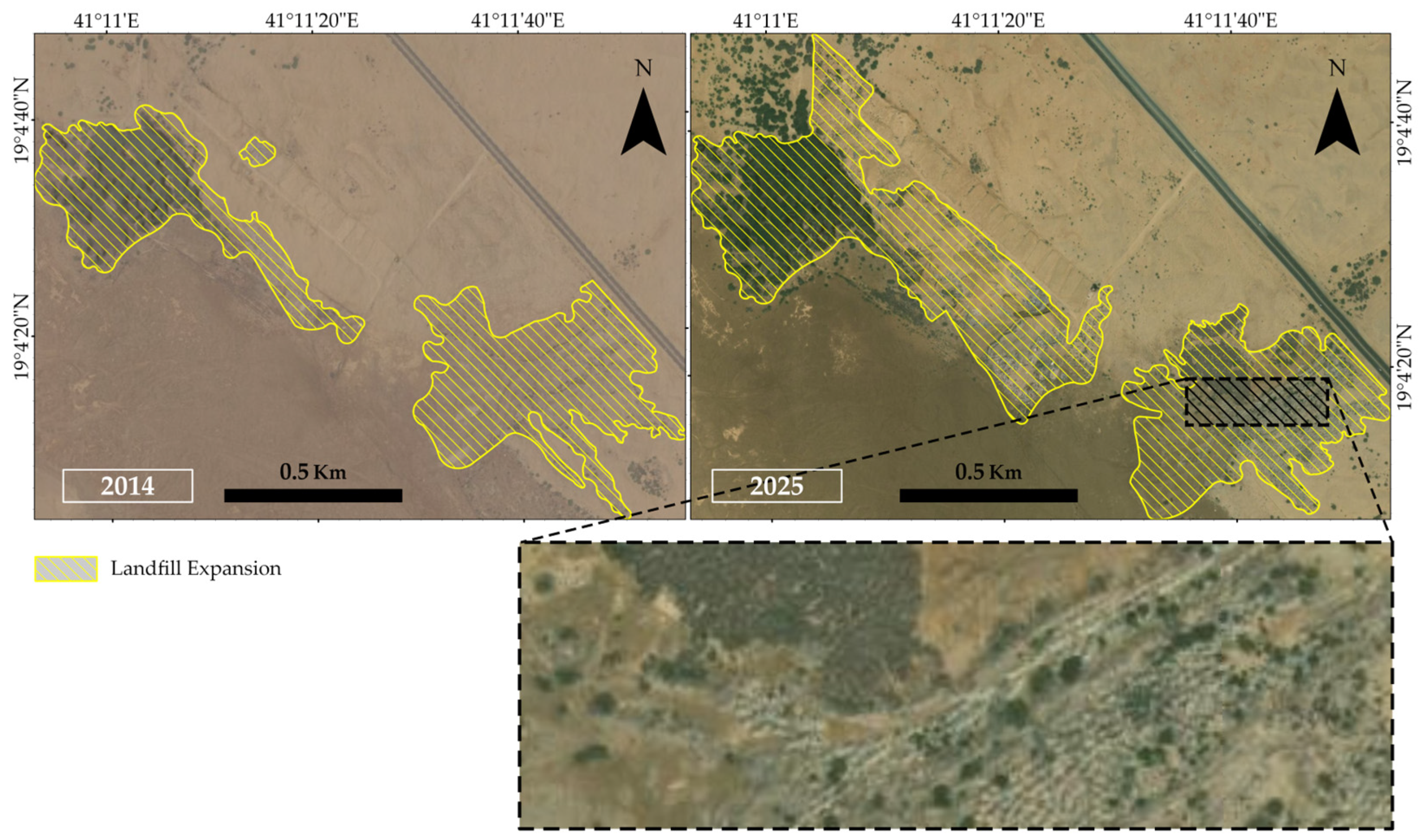
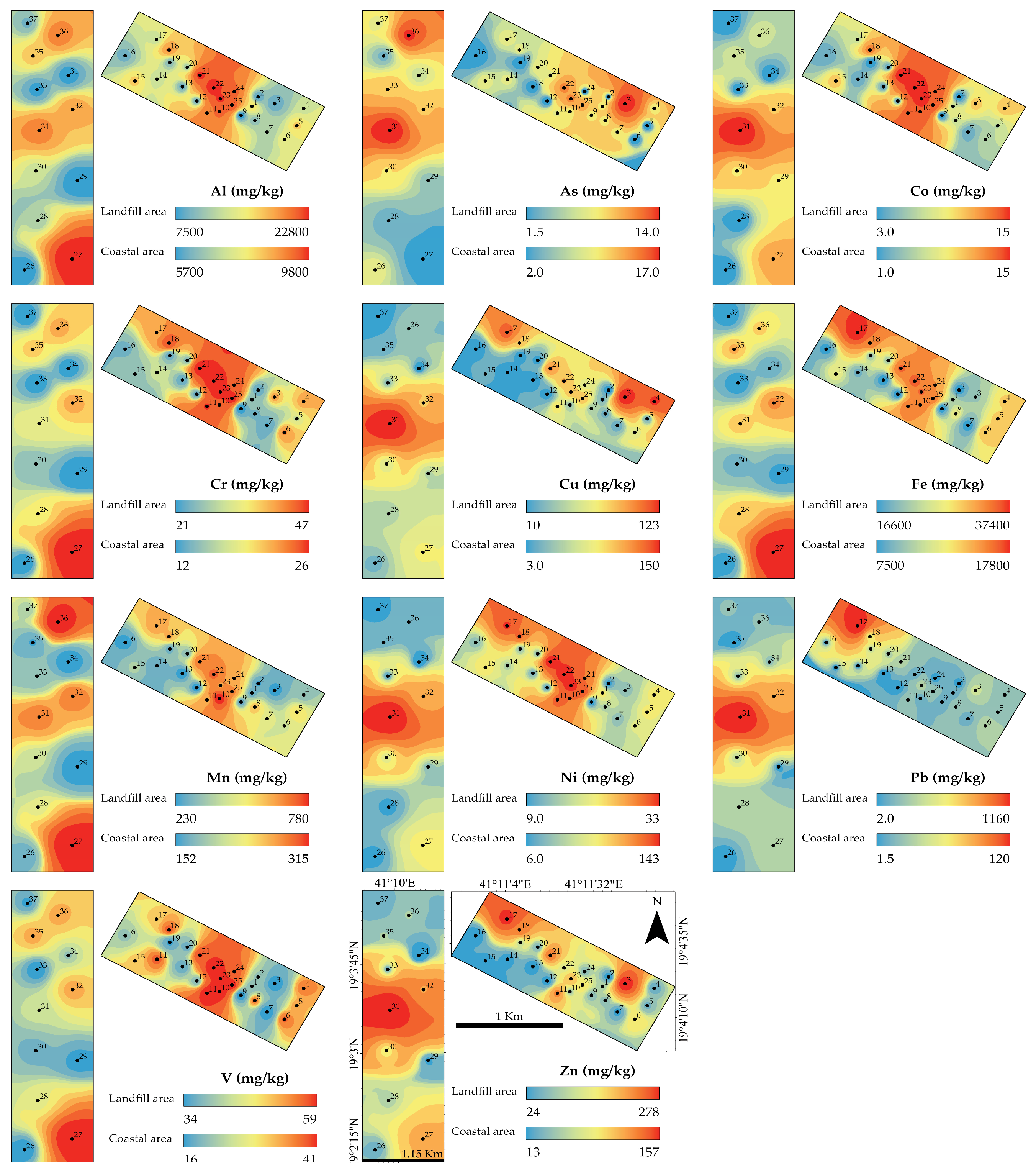

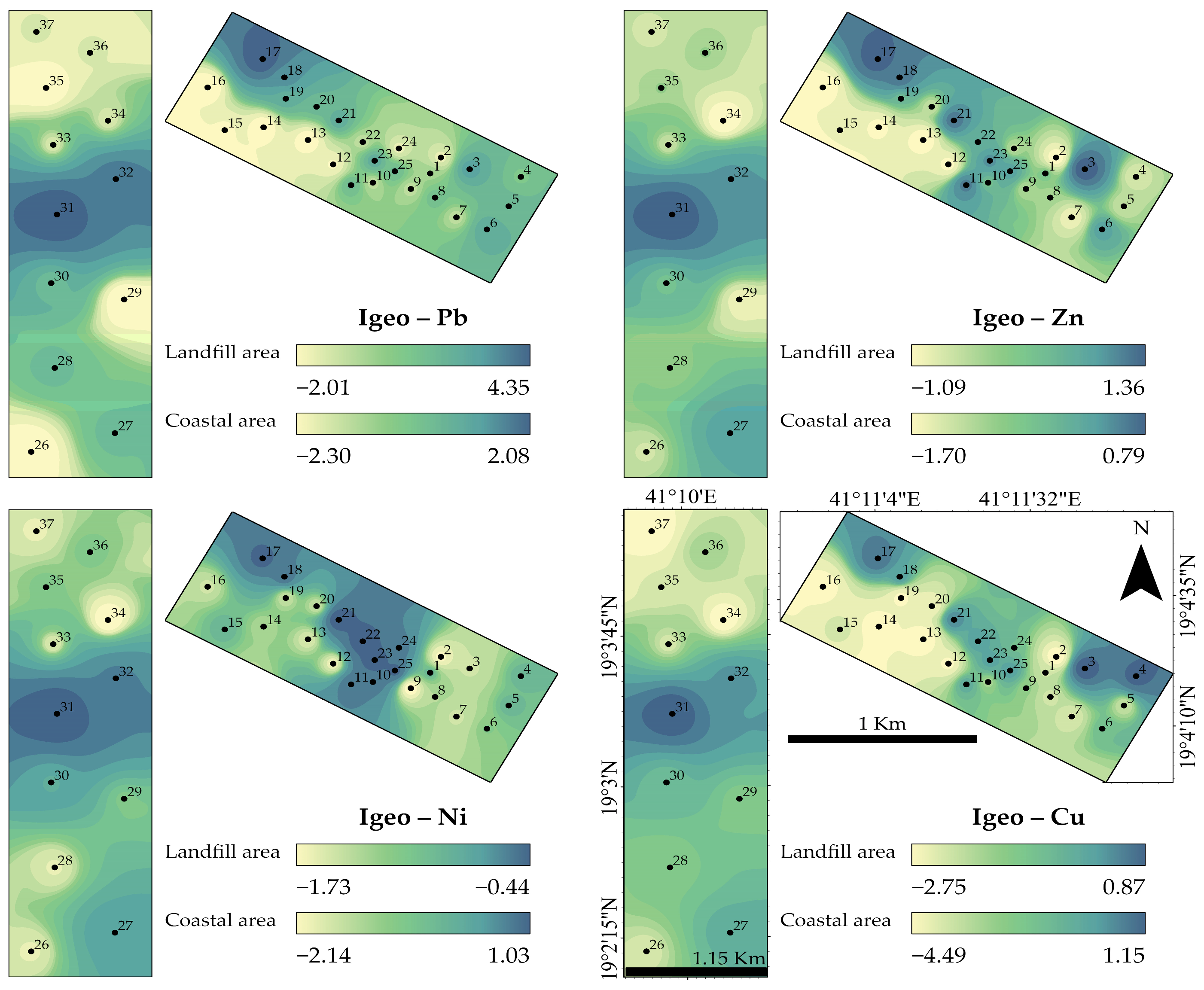
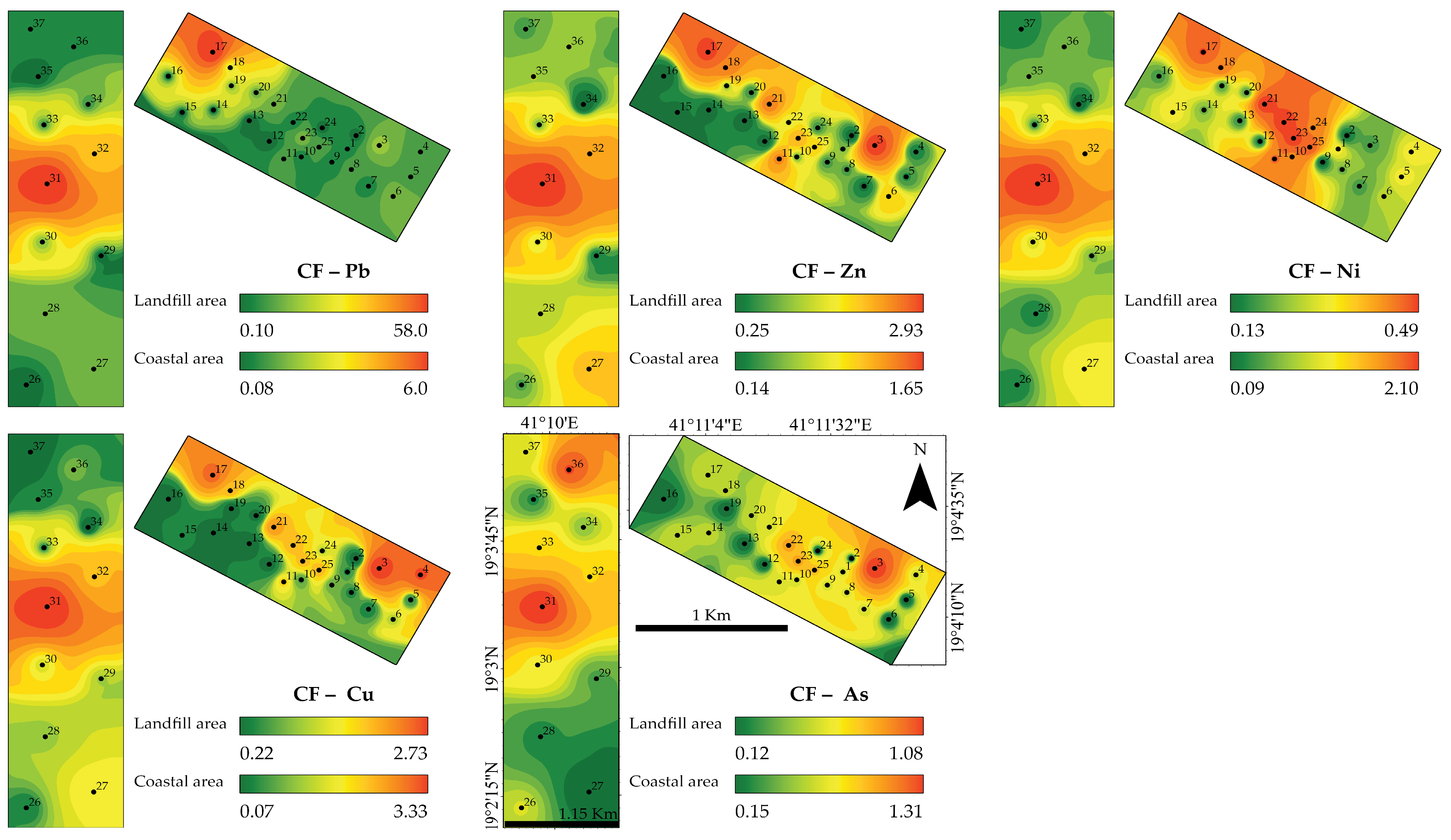
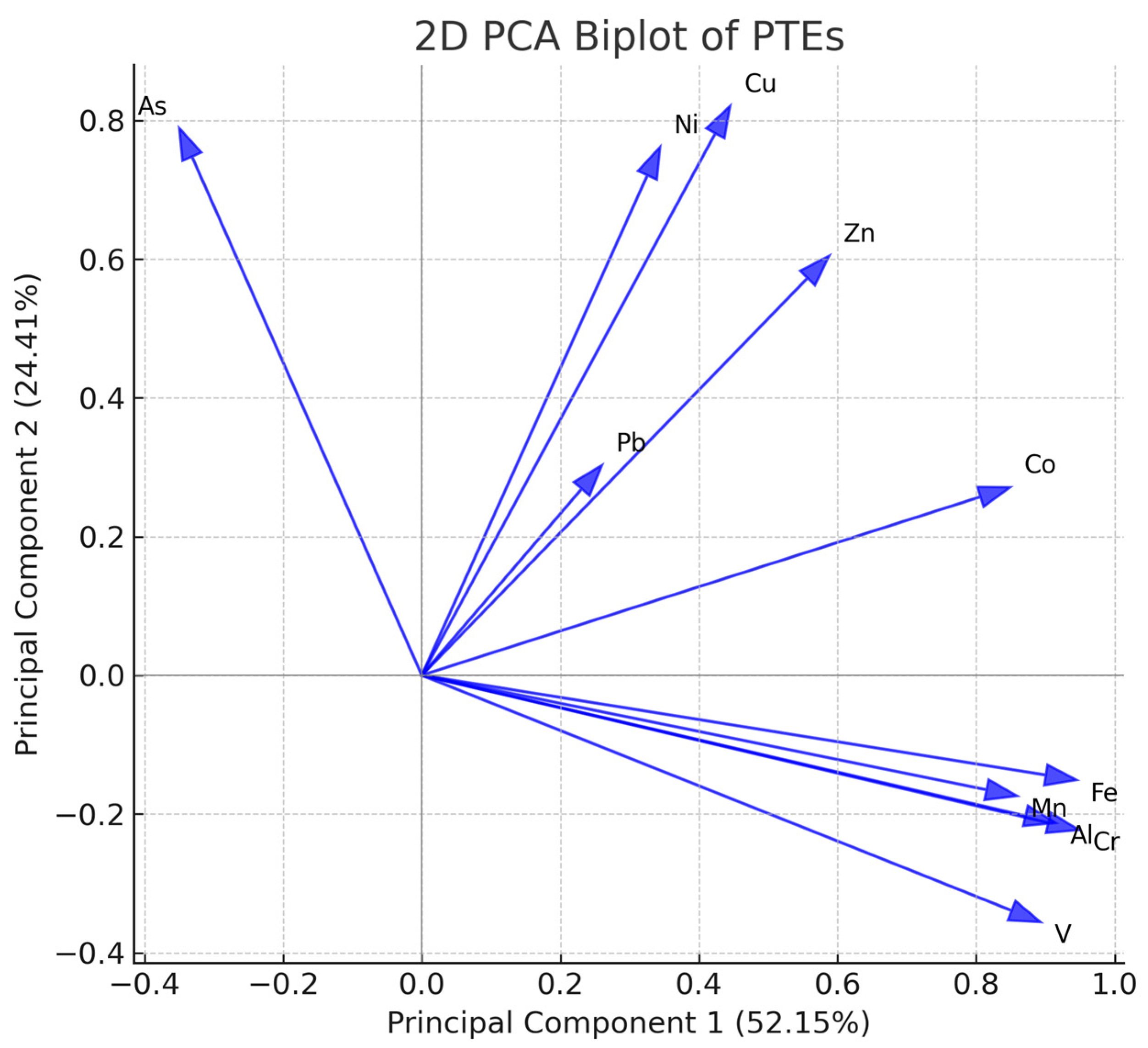
| PTEs | Mean Conc. | ERL | ERM | <ERL (%) | >ERL & <ERM (%) | >ERM (%) |
|---|---|---|---|---|---|---|
| Cu | 29.92 | 34 | 270 | 75.67 (28) | 24.33 (9) | 0 |
| Ni | 22.10 | 20.9 | 51.6 | 70.27 (26) | 27.03 (10) | 2.70 (1) |
| Zn | 65.36 | 150 | 410 | 91.89 (34) | 8.11 (3) | 0 |
| As | 4.47 | 8.2 | 70 | 91.89 (34) | 8.11 (3) | 0 |
| Cr | 26.74 | 81 | 370 | 100 (37) | 0 | 0 |
| Pb | 69.51 | 46.7 | 218 | 58.33 (35) | 2.70 (1) | 2.70 (1) |
| PTEs | Mean Conc. | USEPA Residential SSL | Exceeds SSL (%) |
|---|---|---|---|
| Pb | 69.51 | 400 | 2.70 (1) |
| Cu | 29.92 | 70 | 0 |
| Ni | 22.10 | 30 | 27.03 (10) |
| As | 4.47 | 0.39 | Significant |
| Cr | 26.74 | 210 | 0 |
| Zn | 65.36 | 2300 | 0 |
| Al | As | Co | Cr | Cu | Fe | Mn | Ni | Pb | V | Zn | |
|---|---|---|---|---|---|---|---|---|---|---|---|
| Al | 1 | ||||||||||
| As | −0.380 * | 1 | |||||||||
| Co | 0.843 ** | −0.011 | 1 | ||||||||
| Cr | 0.936 ** | −0.470 ** | 0.747 ** | 1 | |||||||
| Cu | 0.182 | 0.429 ** | 0.553 ** | 0.263 | 1 | ||||||
| Fe | 0.825 ** | −0.511 ** | 0.644 ** | 0.921 ** | 0.308 | 1 | |||||
| Mn | 0.843 ** | −0.330 * | 0.711 ** | 0.790 ** | 0.174 | 0.802 ** | 1 | ||||
| Ni | 0.203 | 0.421 ** | 0.656 ** | 0.110 | 0.728 ** | 0.125 | 0.176 | 1 | |||
| Pb | 0.001 | −0.041 | 0.026 | 0.085 | 0.293 | 0.423 ** | 0.169 | 0.164 | 1 | ||
| V | 0.847 ** | −0.610 ** | 0.625 ** | 0.941 ** | 0.152 | 0.909 ** | 0.780 ** | 0.045 | 0.085 | 1 | |
| Zn | 0.312 | 0.224 | 0.480 ** | 0.459 ** | 0.794 ** | 0.566 ** | 0.331 * | 0.430 ** | 0.517 ** | 0.314 | 1 |
| KMO and Bartlett’s Test | ||
|---|---|---|
| Kaiser–Meyer–Olkin Measure of Sampling Adequacy. | 0.644 | |
| Bartlett’s Test of Sphericity | Approx. Chi-Square | 628.227 |
| df | 55 | |
| Sig. | 0.000 | |
Disclaimer/Publisher’s Note: The statements, opinions and data contained in all publications are solely those of the individual author(s) and contributor(s) and not of MDPI and/or the editor(s). MDPI and/or the editor(s) disclaim responsibility for any injury to people or property resulting from any ideas, methods, instructions or products referred to in the content. |
© 2025 by the authors. Licensee MDPI, Basel, Switzerland. This article is an open access article distributed under the terms and conditions of the Creative Commons Attribution (CC BY) license (https://creativecommons.org/licenses/by/4.0/).
Share and Cite
Alharbi, T.; El-Sorogy, A.S.; Rikan, N.; Algarni, H.M. Impact of Landfill Sites on Coastal Contamination Using GIS and Multivariate Analysis: A Case from Al-Qunfudhah in Western Saudi Arabia. Minerals 2025, 15, 802. https://doi.org/10.3390/min15080802
Alharbi T, El-Sorogy AS, Rikan N, Algarni HM. Impact of Landfill Sites on Coastal Contamination Using GIS and Multivariate Analysis: A Case from Al-Qunfudhah in Western Saudi Arabia. Minerals. 2025; 15(8):802. https://doi.org/10.3390/min15080802
Chicago/Turabian StyleAlharbi, Talal, Abdelbaset S. El-Sorogy, Naji Rikan, and Hamdi M. Algarni. 2025. "Impact of Landfill Sites on Coastal Contamination Using GIS and Multivariate Analysis: A Case from Al-Qunfudhah in Western Saudi Arabia" Minerals 15, no. 8: 802. https://doi.org/10.3390/min15080802
APA StyleAlharbi, T., El-Sorogy, A. S., Rikan, N., & Algarni, H. M. (2025). Impact of Landfill Sites on Coastal Contamination Using GIS and Multivariate Analysis: A Case from Al-Qunfudhah in Western Saudi Arabia. Minerals, 15(8), 802. https://doi.org/10.3390/min15080802







